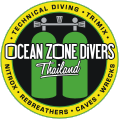
![]()
- Dedicated Tech
- Top Instructors
- Custom Facilities
- Professional Service
- Fun & Friendly
- Local Knowledge




![]()
Technical Diving FAQs
diving > tech diving faqs
1. Technical Diving defined?
Technical Diving is defined as diving beyond the limits of recreational diving; diving with mandatory decompression stops, diving in overhead environments such as caves or wrecks, diving at depths exceeding 40m or simply dive for longer bottom times, diving mixes different to air such as Nitrox, Heliox and Trimix. Technical Diving is a more advanced form of diving that requires more knowledge, more equipment and more expert training.
2. What is Nitrox?
Nitrox is the name given to Oxygen and Nitrogen Mixes where the fraction of oxygen is higher than the normal content of air. The point is to reduce the Nitrogen content allowing for longer dives in shallower waters. It’s also used to optimize decompression dives by increasing the extraction process of dissolved inert gases.
3. What Heliox or Trimix?
Heliox and Trimix are breathing gases where a portion of the Nitrogen and Oxygen has been replaced by Helium in order to reduce the ill effects of high partial pressure of both Oxygen and Nitrogen. Diving with Trimix requires special procedures and thorough understanding of the physics and physiology.
4. What is a Rebreather?
Rebreathers are an optimized gas delivery system that recycle exhaled gas. This is possible because we consume only a small portion of the inhaled Oxygen to satisfy our metabolic needs and can re-use exhaled gas by simply trapping the carbon dioxide in a chemical compound known as Sorbe. There are many different types of Rebreathers that all offer different features and benefits. The most common reasons for using rebreathers are: reduced quantity of bubbles (ideal for photo and video), increased gas reserves, better marine life interaction, and finally some physiological advantages
5. What is an overhead environment?
We define overhead environments as dives in which heading directly for the surface during an emergency is not possible. Typical examples of this situation are; cave diving, wreck penetration or simply decompression diving. Overhead environments are the most challenging forms of diving that should not be tempted without proper training.
